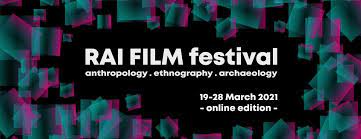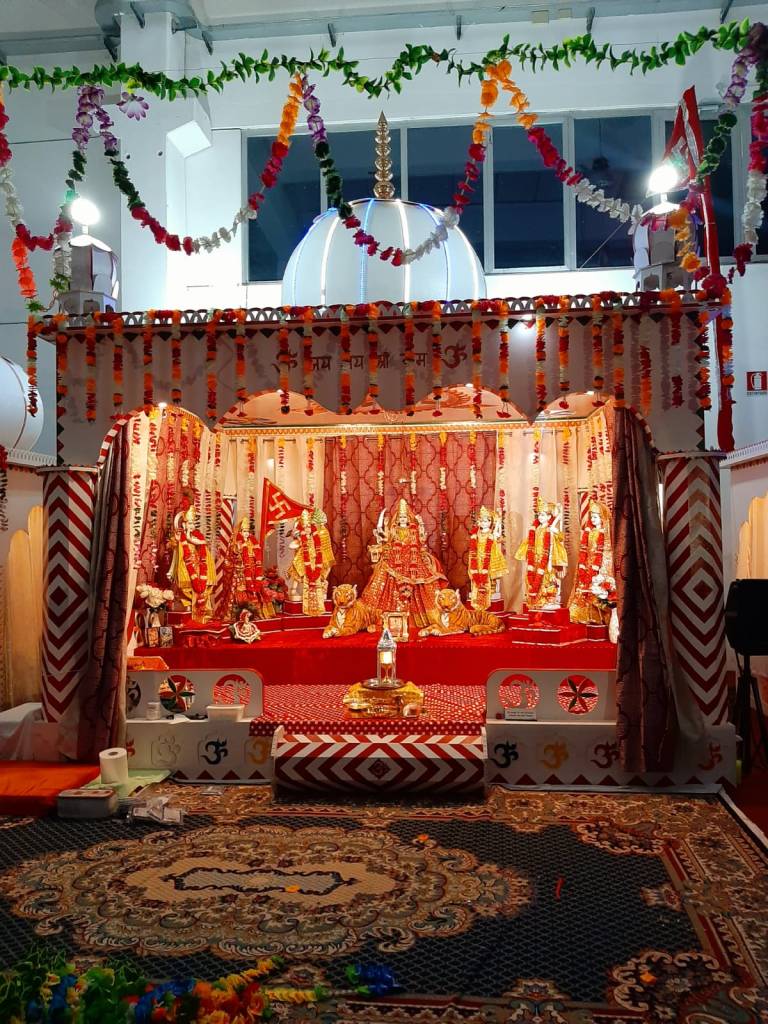by Sara Bonfanti
RAI Film Festival 2021 – online edition was a rich, engaging and varied event that brought together the leading voices in the field of visual anthropology to interrogate cutting-edge documentary film practice. Over ten days, 19th – 28th March, the festival staged prize-winning films, panels, workshops, as well as Q&As with filmmakers, innovatively blending pre-recorded content with live debates and events.

Among the highlights: Racial justice and anti-racism creative tributes featured prominently across the festival, with Zacharias Kunuk’s film One Day in the Life of Noah Piugattuk (2019), which received the RAI President’s Award; curated exhibitions Global Racialisations strand, and Decolonising the Archive , and the Anti-racist Filmmaking workshop hosted by the EthnoCine collective. Keynotes were delivered by Faye Ginsburg (NYU) who drew on her collaborative work with First Nations/Inuit media makers in Canada and Australia, and Stephanie Spray (USC-Dornsife) who upheld the importance of “maintenance” to creative work during our time of crisis and its power for social transformation. An expanded strand of short films offered 10 thematic programmes, including a section on Migration at the Crossroads, and another on Women, empowerment and Religion, which the author of this post binge-watched at night, like shooting stars at digital reach.
For a seasoned ethnographer and apprentice visual filmmaker like myself, no better place to start than presenting a contribution to the Film Festival Conference Creative Engagement with Crisis. Whilst Covid-19 has thrown us into an unprecedented global situation, anthropologists have been grappling with crises of various kinds and magnitudes well before this moment. How are visual anthropologists and the communities that have been working with responding to the crises of our times? How might research work in film and related media help us to move beyond the disruption to renew and rethink visual and sensory anthropology?
Scrolling down the conference timetable https://raifilm.org.uk/2021-conference-panels/, the original film project supported by HOMInG “Of Domes and Robes” was part of a lively discussion convened by Timothy Cooper (Cambridge) and Till Trojer (SOAS) around the theme Crisis, creativity and ethics: reflexive practices and critical engagements with “others” in times of uncertainty. A line-up of excellent contributors animated two sessions of the panel, which also included Nick Mai (Newcastle) and Keri Dahlgren (Melbourne), who respectively reflected on the renegotiation of doing ethno-fiction with Chinese migrant sex workers and on the possibilities for online video ethnography during the COVID-19 pandemic. As it often occurs, while ethnographic case studies spanned wide and large, a consistent engagement with how anthropologists deal with the unexpected together with their participant communities, run across all talks and ignited an excellent debate, where Marie Rosamojo (London Metropolitan) added a critical voice, screening her auto-ethnography of queer and mixed-race identity.
With my oral contribution (and preview of selected footage), I tried to engage the audience-spectatorship in suggesting solutions for a better representative co-editing. In my paper: Video-ethnographic reflections (with)in houses of worship ‘gone viral’: from shut doors to cagey reopening, I addressed how my co-director and I had navigated filming on and off lockdowns. We pondered: How can ethnographers keep filming in the midst of a pandemic upon stringent conditions? What kind of haggling takes place between researchers and participants if the locations and live actions once agreed for shooting have suddenly turned into an arena of mistrust and precautions? Now that we considered our live shooting done, and we could make up for missed events thanks to archival materials supplied by our research partners, to what extent could we stretch their participation also into the editing process? Our medium-length ethnographic film is forthcoming shortly, hopefully by next month. Wajahat Abbas Kazmi and I wish to thank our friends at the RAI FF for their sincere interest in our work and for their generous advice; collaboration in research and film-making takes more venues than anticipated.

Notwithstanding digital fatigue, I did enjoy many of the screenings and talks which were delivered online (how did I miss the Watershed though, independent cinema and cross-art centre on Bristol’s historic harbour side, which had hosted the last editions of the RAI FF!). And here come my personal endorsements.
Of all conversations with authors, the roundtable on Paul Henley’s Beyond Observation (2020) delivered a grand tour of the anthropological gaze: from the birth of cinema in 1895 up to (nearly) the present day. Henley challenges us to reconsider how anthropologists tell and pass on the legacy of ethnographic film. What is the canon of ethnographic film? Who decides? And do we really need one?
Caterina Sartori (RAI) organized a remarkable Panel on Housing loss and insecurity, engaging with the way researchers, artists, residents and activists mobilise audio-visual tools to make sense of this predicament. Andy Lawrence (Manchester), author of the recent handbook Filmmaking for Fieldwork, co-convened a homonymous Panel looking at the modes and impacts of ethnographic filmmaking across disciplines, enquiring the interpretative spaces through which audiences contribute to re-imagine complex realities. Maruska Svasek (Queen’s Belfast) chaired a timely Panel on Rethinking fieldwork: ethnography in lockdown, seizing unprecedented opportunities and affective interaction between researchers and participants also working from/at home.
Among the most original features of the festival, Imagine(ing) migration. The aesthetics of borders and resistance. The exhibition, curated by students of the MA Migration and Diaspora studies at SOAS, showcased a provoking collection of artworks ranging from video, collage and illustration to poetry and diary-writing which tried to respond creatively to questions such as: Is this the “age of migration”? What challenges do diasporic communities bring to modern political constructions such as the nation-state? Ruba Salih introduced her students’ presentations. She also made a plea for a radical re-rethinking of pedagogical methods at university level, calling for ethnographic research to go beyond ‘traditional, canonical’ methods and to allow for creative experiments that challenge how we see reality. (Preview here: https://www.youtube.com/watch?v=_5Ge8TWPBT8)

Possibly the most memorable movie I watched last week comes from the Ethnomusicology subgenre: In Search of Bidesia (2019), by genial filmmaker Simit Bhaght (Teaser here: https://www.youtube.com/watch?v=CV6Dmc8rpCM). In the Indian language of Bhojpuri the name ‘Bidesia’ refers to a person who has migrated to a foreign land. However, Bidesia is also the name of a genre of Bhojpuri folk music, which reflects the history of the pain and loss of the indentured labourers who migrated from the states of Uttar Pradesh and Bihar from the 19th century. This film is a journey to find the last musical expressions of this history still present in contemporary artists, whose songs tell the story of millions of forgotten Indian slaves who laboured on plantations and construction sites throughout the British colonies.
Worth mentioning is also the documentary Not in my Neighbourhood (2018) by Kurt Orderson, which tells the intergenerational stories of spatial violence in three self-professed world-class cities: Cape Town, New York and São Paulo. Following the daily struggles, trials and successes of active citizens, fighting for the right to their cities, the film aims to build solidarity among active urban citizens by illuminating how urban activists shape and navigate their cities, which have been affected by colonization, architectural apartheid and gentrification. Preview here: https://vimeo.com/237044326
As for the winners: TheRAI Film Prizewas won by Tanja Wol Sørensen, director of A Colombian Family, a powerful mother-daughter drama set against civil war and exile.TheBasil Wright Prizewas awarded to Mattijs van de Port forThe Body Won’t Close,portrait of a capoeira hero whose physical boundaries echo the symbolic ones of his people in Bahia. TheRichard Werbner Awardfor Visual Anthropologywas delivered to Dipesh Kharel, Frode Storaas for A Kali Temple Inside Out, a mesmerizing counter narrative to religious antagonism in India as popularised by news media. RAI Film Lifetime Achievement Award was presented to André Singer, filmmaker and anthropologist for his longtime contribution to the field, including his latest project as producer, Fireball (dir. by Herzog and Oppenheimer, 2020).
Last, in recognition of the debt of gratitude that RAI Film owed to a most beloved Dean of Anthropology at Oxford, Marcus Banks, a film tribute from his friends, colleagues and students was presented—a reflection of his contributions to the field of visual anthropology over the course of the past four decades. As my own way to pay homage to his legacy and make it speak directly to my visual anthropology endeavours, let me revive his suggestion (Banks, 2014: 81): “One of the great strengths – and frustrations – of film, photographs and other images is their refusal to be confined by either text or context. […] Allowing images the space and the time to breathe, by tailoring our research to their sometimes painfully slow agendas rather than the other way around, can yield great insight.”
References cited:
Banks, Marcus (2014). Slow Research: exploring one’s own visual archive. Cadernos de Arte e Antropologia, 3(2), 57-67.
Henley, Paul (2020). Beyond observation: A history of authorship in ethnographic film. Manchester University Press.
Lawrence, Andrew (2020). Filmmaking for fieldwork: A practical handbook. Manchester University Press.
